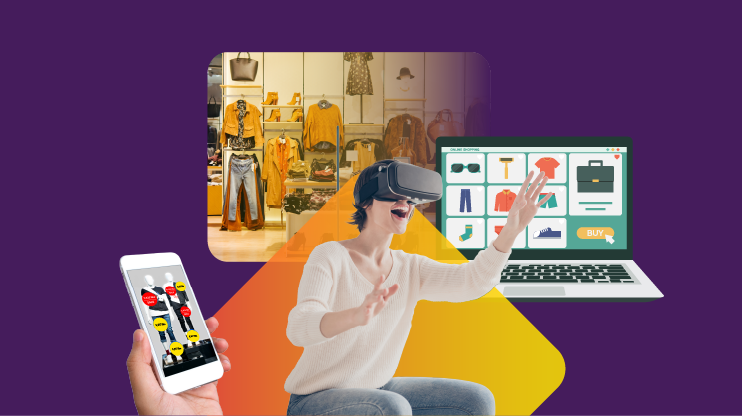“More often than not, the retail sector functions exactly the way that it did 20 years ago,” said Cate Trotter, Head of Trends for Insider Trends. “The retail industry is not changing as fast as other trend spotters might tell you, particularly in the physical channel. If we fast forward 10 or 20 years, I’m not sure we will need retail in its traditional state.”
Trotter is a futurist, speaker, influencer, strategist, and consultant who works with retailers and direct-to-consumer (DTC) brands around the globe to improve their omnichannel retail strategy, spur innovation, and boost commerce with easy wins. She was the guest on “Is Physical Retail Dead?” hosted by Sergio Iacobucci, Director of Product Marketing for Coveo, part of a new podcast series from Coveo called “The Ecom Edge.”
Although she has heard many brick-and-mortar retailers talk about how they are creating highly customer-centric environments focused on customer engagement, “I don’t see a lot of that in most stores I visit,” Trotter said. “Mostly it’s just walking up and down aisles of shelves and locating the item that you want by yourself. It’s not particularly inspiring or efficient customer service”.
Companies that continue to bet on physical locations as the primary and only marketing channel are going to be in peril, according to Trotter.
“We recommend that our clients think digital-first,” she explained. “There are definite advantages to having stores, but if retailers looked at all the different methods of interaction they have at their disposal, they wouldn’t rely as much on [physical] stores as they do today.”

Why Is Omnichannel Important Now?
It’s hard to find a retailer or brand that doesn’t say it is dedicated to providing a personalized omnichannel experience, but “customers don’t compare retail experiences to other retail experiences. They compare them to the best experiences they’ve had anywhere,” Trotter noted. That means omnichannel shoppers are prone to compare a retailer’s personalized recommendations to Netflix and Spotify, its fulfillment and delivery to Amazon, and its convenience to Doordash.
Consumers will increasingly compare their digital experiences to the metaverse, a term that was elevated into mass consciousness when Facebook Inc. changed its name to Meta. “The metaverse will feel like a hybrid of today’s online experiences on social experiences, sometimes expanded into three dimensions or projected into the physical world,” according to the company. “It will let you share immersive experiences with other people even when you can’t be together-and do things together you couldn’t do in the physical world.”
Not much is known about the specifics of the metaverse, but Trotter predicts it will enable the brand and marketer to “connect with customers in a way that doesn’t have to be constrained by physical requirements.”
In the meantime, retailers and brands can experiment with digital transformation by looking at immersive 3D digital stores, which have become more affordable. “It doesn’t have to cost a lot of money to experiment with some of these bleeding-edge, digital-first environments, and now is a good time to start playing around with them,” she said.

What’s the Future of Omnichannel Retailing?
Transformative technologies will shape the future of omnichannel retail. These include virtual reality (VR), augmented reality (AR), artificial intelligence, cloud computing, smart sensors, 3D printing, nanotechnology, smart materials, green technology, and sustainable energy. When Trotter and Iacobucci continued their conversation in the episode titled, “The Future of Retail: Trends and Technology to Upgrade your Ecommerce Strategy” Trotter emphasized that technology is driving change in omnichannel commerce at an exponential rate, magnified by the number of technologies that are simultaneously maturing.” All these (named above) individually accelerating technologies are going to start interacting with one another even more,” she added.
“I would argue that the leading retailers of 2035 will be more like tech companies than retailers, and they don’t even exist yet,” Trotter said. “We can expect them to come out of nowhere and amaze us all.”
That doesn’t mean retailers and brands should become paralyzed by uncertainty. By focusing on their strengths and understanding customer interaction, each brand or retailer can find “their right technologies and their right next steps,” Trotter said.
In addition, retailers will have to work harder at data collection to get the digital customer data they have become accustomed to getting rather easily. The three major web browsers-Chrome, Safari, and Firefox-will have eliminated third-party tracking cookies by the end of 2022. And Apple’s latest operating systems for iPhones, iPads, MacBooks, and Apple Watches allow users to block third-party tracking pixels and mask their IP addresses.
Trotter noted that the British Broadcasting Corporation (BBC), the UK’s publicly funded but independently operated media organization, is working on a solution called My PDS (Personal Data Store) that would allow consumers to secure the data multiple sources have gathered about them and decide how and with whom they will share their data.
The project is at a very early stage, but the BBC said, “This work provides ground-breaking new ways to make data a force for good. It benefits people and society by letting users decide how information about them is used to make decisions and predictions.”
How Effective Is Omnichannel Marketing?
But it looks like the omnichannel personalization strategy deployed by brands doesn’t always meet customer expectations: from a survey of 4,000 shoppers across the U.S. and UK by Coveo, while 47% said they expected online shopping to be as good as or better than in-person, but only 13% said they had an online shopping experience that felt personalized to their specific buying habits.
Like customer experience, omnichannel personalization is a retail buzzword, and “most big brands would say their in-store experience is better than their online experience,” Iacobucci observed.
Trotter countered that “Ecommerce can surpass the in-store experience,” but most retail brands aren’t there yet, incapable of providing a seamless customer experience online. Her advice for bridging the gap?
The first step is making sure they have the best possible business for now, Trotter responded. “Huge gains, that can be made just by refocusing on bread-and-butter things. If you can get an increase of a couple of percent in a few areas, all of that compounds, and you can change the fortunes of a business very quickly,” she said.
To go forward, she advises, brands should “take a massive blank sheet of paper and think:
- What would I do if I was starting again?
- How would I connect with a potential customer?
- How would I bring my brand to life?’
And then work backward from that.


